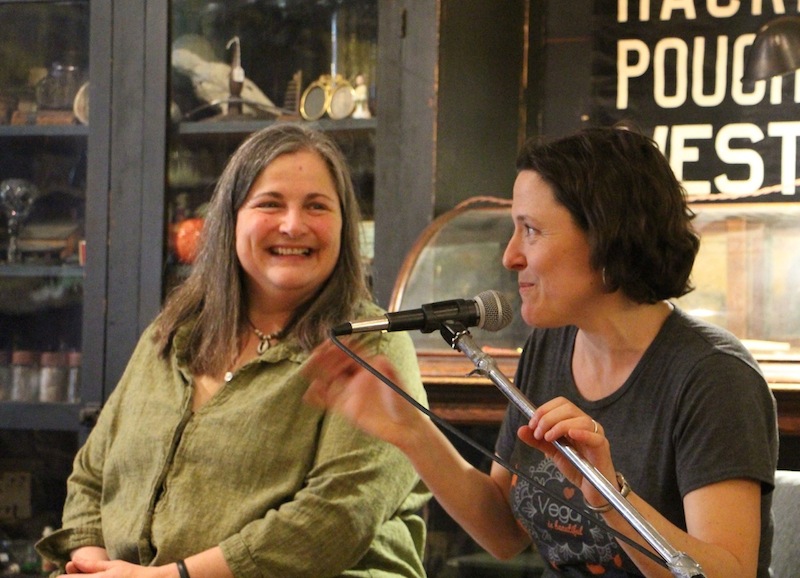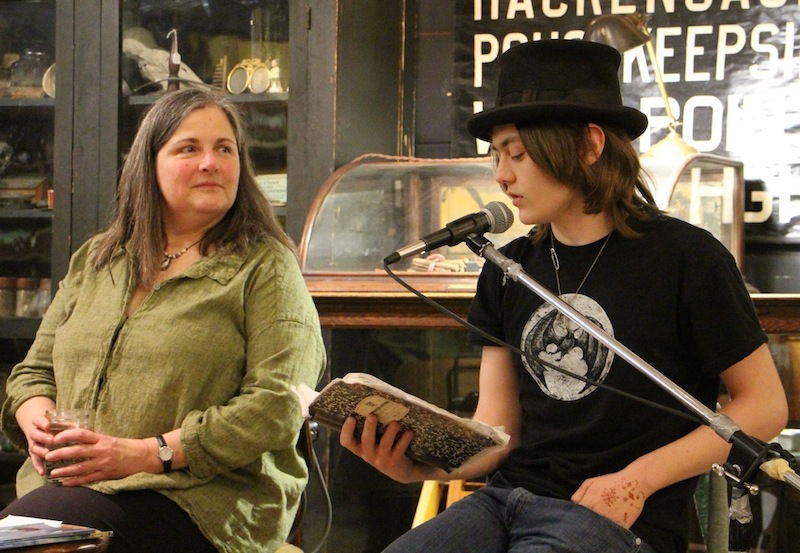April 16, 2015
 Gretchen Primack treated a rapt group to a reading of poems in many forms: sonnets, haiku, iambic pentamenter in tercets, a suite of Yiddish-inflected limericks, an ekphrastic poem (i.e. inspired by another art form) and “a form only real poetry nerds will know,” a paraclausithyron, or lament sung through a lover’s locked door. She found this and other deliciously obscure forms in The Teachers and Writers Handbook of Poetic Forms (which you can order it from The Golden Notebook, where she works on Sundays and Mondays).
Gretchen Primack treated a rapt group to a reading of poems in many forms: sonnets, haiku, iambic pentamenter in tercets, a suite of Yiddish-inflected limericks, an ekphrastic poem (i.e. inspired by another art form) and “a form only real poetry nerds will know,” a paraclausithyron, or lament sung through a lover’s locked door. She found this and other deliciously obscure forms in The Teachers and Writers Handbook of Poetic Forms (which you can order it from The Golden Notebook, where she works on Sundays and Mondays).
So: why form, and how freedom? Gretchen defined “received forms” (forms offering preset rules, which of course you can break, bend, or alter) as “something from the outside that gives you limits, which is ridiculously freeing.” She later described the sonnet form as a garden trellis, with the set number of lines providing a scaffold on which a vine can “climb freely and do crazy things,” adding, “It’s so comforting that you have this structure. You will write a different poem than if you sat down and wrote free verse, guaranteed.” (For the record, Gretchen also writes free verse, and beautifully: see Doris’s Red Spaces, Kind, and The Slow Creaking of Planets for examples of her poems, both trellis-and-vine and free-range.)
She pointed out that received forms were “all there was in the Western tradition” until Walt Whitman busted it open, redefining notions of what poetry can be. Whitman’s long lines were a revelation; Gretchen says most poets habitually gravitate to lines and poems of similar lengths, and that using short lines (“poems shaped like Chile”) or very long ones can “shake things up, in a good way.”
Poetry requires “such an attention to every element on the page, a heightened attention to language and form.” Reading poetry requires time, slowing down to savor and linger. Nina added that poetry calls in all the other art forms, with its attention to visual layout on the page, to musical rhythm, and to the performer’s breath. It’s also a form that demands concision, Gretchen affirmed. “I really like the idea of sloughing off chaff. I like cutting away what isn’t necessary, leaving just that plump, polished seed.”
This attention and focus was demonstrated immediately, as we had the quietest mid-class break in the history of Word Café, with a record number of people coming forward to read wonderful short poems and openings.
THE EXERCISES:

Gretchen passed out a worksheet (download pdf) with two exercises. Nutshell version:
— Write ten lines of unrhymed iambic pentameter (iambs are the two-syllable “heartbeat rhythm” of Shakespeare: daDUM, daDUM, daDUM, daDUM, daDUM… Gretchen commented that five iambs is “about the length of a breath.”)
— Read a poem you love (she chose a sonnet from Marilyn Nelson’s “A Wreath for Emmett Till”) and circle five words. Write a new poem that uses those five words.
Nina offered a third formal exercise, riffing off the OCD poetic form called the sestina, which rearranges the same six end-words in a preset pattern, creating a ripple of repeated words. Nina’s “sestina unplugged” has only one rule: the last word in each sentence (prose) or line (poem) must recur somewhere in the following sentence or line. (If you want to add one more sestina rule, circle these “end words” as you go along, and repeat more than one in your final lines.)